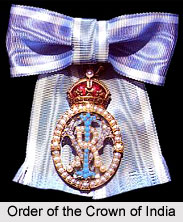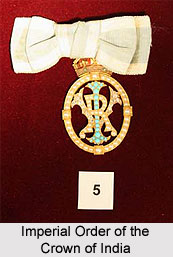 The Order of the Crown of India, also known as the Imperial Order of the Crown of India, was an order in the British honours system. When Queen Victoria became Empress of India, she founded the Order of the Crown of India in the year 1878. The Order was open only to women and no new appointments were made after the Partition of India in the year 1947. The Order was restricted to British Princesses, wives or female relatives of Indian Princes, as well as the female relatives or wives of any person, who held the office of Viceroy of India, Governor General of India, Governor of Madras, Governor of Bombay, Governor of Bengal, Secretary of State for India and Commander-in-Chief in India.
The Order of the Crown of India, also known as the Imperial Order of the Crown of India, was an order in the British honours system. When Queen Victoria became Empress of India, she founded the Order of the Crown of India in the year 1878. The Order was open only to women and no new appointments were made after the Partition of India in the year 1947. The Order was restricted to British Princesses, wives or female relatives of Indian Princes, as well as the female relatives or wives of any person, who held the office of Viceroy of India, Governor General of India, Governor of Madras, Governor of Bombay, Governor of Bengal, Secretary of State for India and Commander-in-Chief in India.
The members of the Imperial Order of the Crown of India were titled Companions and could use the post-nominals "CI". The members were not granted any special precedence or status due to the Order. Moreover they were ennobled to wear the badge of the Order of the Crown of India, which included the Imperial Cypher of VRI (Victoria Regina Imperatrix) of Queen Victoria.
 The letters were arranged in diamonds, pearls and turquoises. These were encircled by a border of pearls scaled by a figure the Imperial Crown. The badge of the Order was worn attached to a light blue bow, edged in white, on the left shoulder. Princess Elizabeth (Queen Elizabeth II) and Princess Margaret, her sister, were appointed to the Imperial Order of the Crown of India in June 1947 by their father King George VI. Queen Elizabeth II is the last surviving former member of the Order. The Duchess of Gloucester, Princess Alice, was the last ordinary member when she died in the year 2004. Prince Henry, the Duke of Gloucester, was the husband of Princess Alice and the last surviving Knight of the Order of St. Patrick, who died in the year 1974.
The letters were arranged in diamonds, pearls and turquoises. These were encircled by a border of pearls scaled by a figure the Imperial Crown. The badge of the Order was worn attached to a light blue bow, edged in white, on the left shoulder. Princess Elizabeth (Queen Elizabeth II) and Princess Margaret, her sister, were appointed to the Imperial Order of the Crown of India in June 1947 by their father King George VI. Queen Elizabeth II is the last surviving former member of the Order. The Duchess of Gloucester, Princess Alice, was the last ordinary member when she died in the year 2004. Prince Henry, the Duke of Gloucester, was the husband of Princess Alice and the last surviving Knight of the Order of St. Patrick, who died in the year 1974.
Members of Order of the Crown of India
The members of the Imperial Order of the Crown of India include the following-
* Her Royal Highness The Princess of Wales (1878)
* Her Royal Highness The Duchess of Cambridge (1878)
* Her Highness Maharani Dhulip Singh (1878)
* Her Highness Sultan Shah Jahan, Begum of Bhopal (1878)
* Her Highness Maharani Sita Vilas Dawaji Ammani Anaro of Mysore 1878
* Her Highness Maharanee Jumnabai Sahib Gaekwad of Baroda 1878
* Her Highness Dilawar Un Nisa Begum Sahiba of Hyderabad 1878
* Her Highness Nawab Qudsia, Begum of Bhopal 1878
* Her Highness Vijaya Mohana Muktamba Bai Ammani Raja Sahib of Tanjore 1878
* Her Highness Maharani Surnamayi of Cossimbazar 1878
* The Countess of Mayo 1878
* Lady Susan Bourke 1878
* The Viscountess Halifax 1878
* Her Highness Bharani Thirunal Lakshmi Bayi, Senior Rani of Attingal 1881
* The Viscountess Cross 1886
* Her Royal Highness Princess Louise of Wales 1887
* Her Royal Highness Princess Victoria of Wales 1887
* Her Highness Maharanee Sakhiabai Raje Sahib Scindia Bahadur, Regent of Gwalior 1891
* Her Highness Maharanee Chimnabai Sahib Gaekwad of Baroda 1892
* Her Highness Lady Nandkuverbai Bhagvatsinh Jadeja, Rani Sahib of Gondal 1892
* Her Highness Vani Vilasa Sannidhana, Maharani of Mysore 1893
* Her Highness Nawab Sultan Jahan Begum, Begum of Bhopal 1911
* Her Highness Maharani Sri Nundkanvarba of Bhavnagar 1911
* Her Highness Maji Sahiba Girraj Kuar, Maharani of Bharatpur, Regent of Bharatpur 1918
* Her Highness Shrimati Chinkuraja Scindia, Senior Maharani of Gwalior 1928
* Her Highness Puradam Thirunal Sethu Lakshmi Bayi, Senior Maharani of Travancore 1929
* Begum Mariam Sultana, Lady Ali Shah 1932
* Her Highness Maharani Tara Devi of Jammu and Kashmir 1946
* Her Royal Highness The Princess Elizabeth 1947
* Her Royal Highness The Princess Margaret 1947



















